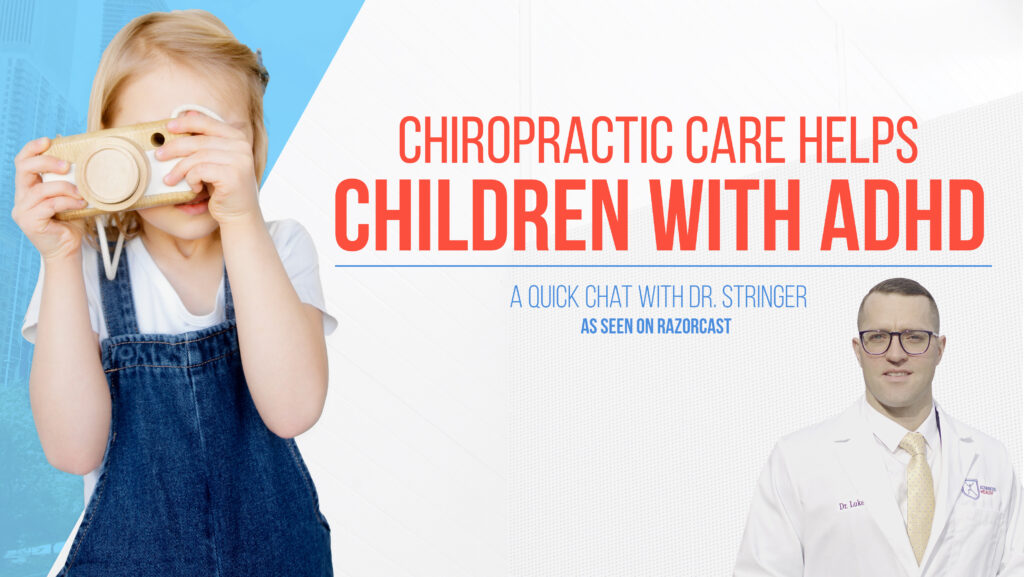
ADHD stands for Attention-Deficit Hyperactivity Disorder. What that means is kids specifically have quite a tough time paying attention and controlling impulse behaviors and are overly active. ADHD is one of the most common neurodevelopment disorders that we find in kids. It’s usually diagnosed in childhood, but it can last all the way into adulthood.
It’s quite normal for children with ADHD to really struggle with the ability to focus and dial in and pay attention to a task. There are varying degrees of ADHD from mild to severe. The general symptoms that we see within the clinic are a lack of concentration in the classroom, forgetfulness, and hyperactivity. The children are squirming, fidgeting, talking a bunch, losing things, making mistakes from taking unnecessary risks, and having a really tough time focusing and staying on task.
Typically, when we evaluate all the kids that we treat with sensory disorders, we’re always looking at the upper cervical spine. We do that via an evaluation, orthopedic exam, neurological exam, and then we take x-rays. When we’re looking at the x-ray, we’re looking for alignment and the biomechanics of the spine. What we’re finding is the spine in these kids that are suffering with ADHD has either gone straight and/or it’s gone forwards, and we have a reduction of the curve. The spine works in something called kinematics: if one area of your spine goes one way, the other body parts go the other way. We are built to be upright, that’s why we’re bipedal. We’re built to move, and obviously we have eyes in front of our head to look forward.
Typically what we see in these kids is, as the neck goes straight and the head goes forward from looking at the phone or the tablet nonstop, the head goes back up into extension, so the eyes are level. That shuts the space between the occipital bone at the base of your skull and C1, which is the top vertebrae in your neck. There is more nervous system activity in the two nerves at the C1, C2 level, your upper cervical spine, than anywhere else in the spine. That’s right by the brainstem. Your brainstem comes out the hole in your skull, foramen magnum, and then forms the spinal cord, and then the nerves come out of the spinal cord.
If you are consistently stressed in that upper cervical area, you are consistently through what we call subluxations, which are misalignments in the spine in the joint. Then you’re compressing those nerve roots at the C1, C2 level and you create a massive amount of nervous system stimulation. This puts us in our sympathetic tone. Sympathetic tone is that fight-or-fight response. It raises our cortisol levels which is our stress response and it blocks the ability of the body to absorb hormones, particularly adrenaline, which obviously then creates just a catastrophic effect within the body. There are two types of the nervous system within the nervous system. You’ve got the sympathetic nervous system which is your fight-or-flight response and the parasympathetic nervous system where we rest and digest. What we typically find with our kids that are struggling with sensory disorders is they’re consistently plugged into that sympathetic nervous system so they never really get a chance to rest and digest, typically at nighttime.
Chiropractors are essentially doctors of the nervous system. Our clinical training is focused on the treatment of the spine. So the question is, how can we help kids cope with ADHD? Chiropractors can do a maximum amount for your kids that are struggling with ADHD and other similarly sensory disorders. We can clean out those subluxations and take stress and tension off the nervous system. That just allows the child the ability to get back into that parasympathetic nervous system, to process information better, and to have a better ability to adapt to stress. By taking stress off the cervical spine, it helps to take away or at least improve those ADHD symptoms, their ability to concentrate, ability to move, poor dietary habits, lack of appetite, etc.
We can put some goals in place for what the chiropractor, the team within the chiropractor’s office, the patient, and the family are looking towards achieving. From there, we would perform a detailed orthopedic exam, specifically looking for joint function and finding those subluxated joints that shift out of alignment and create stress and tension on the nervous system. And then in between, for any child with ADHD or any sort of sensory disorder, you want to look at the spine. What’s going on in the spine. Where has the spine shifted, particularly in that upper cervical spine.
We collect all the objective data and figure out clinically what’s going on. Those clinical findings, supplemented with that family’s goal, dictate the recommendations. The bare minimum chiropractic is going to be adjusting the spine and removing those subluxations. If we’re going to create any long-term improvement, we should be addressing the structural misalignment in the spine. So we need to evaluate, has our head shifted forward, do we have a straight neck, is our neck reversed? What’s the angle between the skull and the vertebrae in the two top two bones of your neck look like? We will supplement with some physical therapy just to work with the muscles that need to keep the spine alignment. Those muscles sit deep in the neck deep between the shoulder blades.
We need to be patient and just let the body’s innate ability to heal itself kick in. If the nervous system is not under stress, it’s going to allow the body to feel and function both physically and physiologically optimally. That means living without any pain and/or restriction. So, if you are struggling with your child having ADHD or any form of sensory disorder, I highly recommend getting to a chiropractor.
